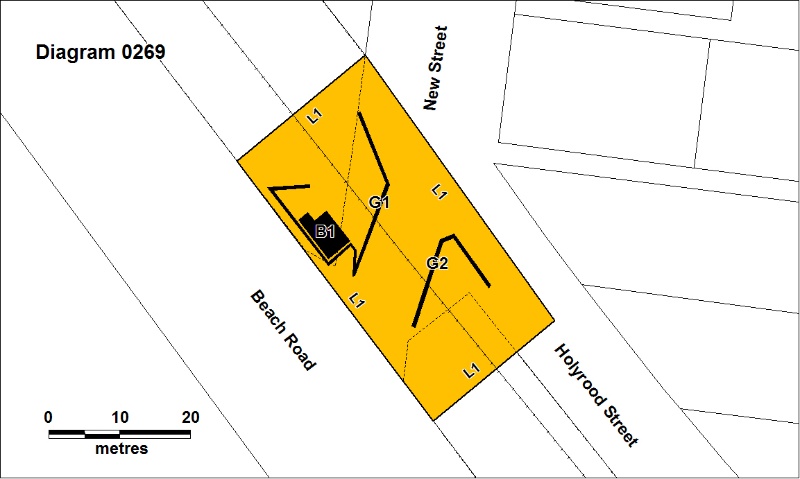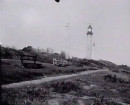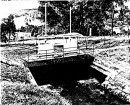NEW STREET RAILWAY GATES
NEW STREET BRIGHTON, BAYSIDE CITY
-
Add to tour
You must log in to do that.
-
Share
-
Shortlist place
You must log in to do that.
- Download report






Statement of Significance
What is significant?
The New Street Railway Gates are located at the intersection of New Street and the Sandringham Railway Line, just inland of the intersection of New Street and Beach Road, and between the Brighton Beach and Hampton Stations. The railway gates are hand operated and are kept open for road traffic. There is a pair of timber gates on each side, flanked by lengths of timber picket fencing and with pedestrian gates on the north side.
The gate-keeper's cabin on the north is a small timber framed weatherboard structure with gabled corrugated iron roof and a single doorway facing the track. A small brick fireplace and chimney are located opposite the door. The signal levers are housed in an open sided timber lean to off the cabin on the crossing side. The weatherboard outhouse with small gable roof is at the other side of the cabin.
The Brighton Beach railway line was extended with a single track to Sandringham, via Hampton Station, in 1887. The line was duplicated in 1902, and the current gate layout probably dates from that time. There were five level crossings with gatekeeper's houses on the line, and as this caused excessive expense, the number of gatekeeper's houses was reduced and some of the crossings closed. From mid-1892 over 900 crossings across Victoria had gates and gatehouses removed. Most of the remaining hand operated gates were in inner suburban areas with a handful at the major country stations.
The addition of signals at crossings began in 1903 with New Street receiving them in 1919. Pedestrian gates were introduced from the 1920s. Mechanically operated gates (sector gates) operated by a wheel from a distance, usually at the signal box, were introduced at inner suburban stations from 1879, with 80 being introduced up to 1935, at which time there were over 60 hand operated gates in Melbourne. Until the 1930s hand operated gates were kept open for trains rather than road traffic. Boom barriers were introduced from 1956. Following continuing installation of booms and grade separations, only 16 hand operated gates remained in the Melbourne suburbs by 1988. Most of these were on the Upfield Railway Line. No other hand operated gates are still in operation, although some of the gates and cabins remain in various locations.
How is significant?
The New Street Railway Gates are of historical and social significance to the State of Victoria.
Why is it significant?
The New Street Railway Gates are of historical significance for their rarity as the last remaining functioning hand operated railway gates in the State and as the most intact hand operated railway gates in the State.
The New Street Railway Gates are of historical significance for their rarity as the last working example of a railway safe-working technology from the late nineteenth century and early twentieth century.
The New Street Railway Gates, while in operation, are of historical significance for their capacity to demonstrate a way of life, working environment and functions once common in Victoria.
-
-
NEW STREET RAILWAY GATES - Permit Exemptions
General Exemptions:General exemptions apply to all places and objects included in the Victorian Heritage Register (VHR). General exemptions have been designed to allow everyday activities, maintenance and changes to your property, which don’t harm its cultural heritage significance, to proceed without the need to obtain approvals under the Heritage Act 2017.Places of worship: In some circumstances, you can alter a place of worship to accommodate religious practices without a permit, but you must notify the Executive Director of Heritage Victoria before you start the works or activities at least 20 business days before the works or activities are to commence.Subdivision/consolidation: Permit exemptions exist for some subdivisions and consolidations. If the subdivision or consolidation is in accordance with a planning permit granted under Part 4 of the Planning and Environment Act 1987 and the application for the planning permit was referred to the Executive Director of Heritage Victoria as a determining referral authority, a permit is not required.Specific exemptions may also apply to your registered place or object. If applicable, these are listed below. Specific exemptions are tailored to the conservation and management needs of an individual registered place or object and set out works and activities that are exempt from the requirements of a permit. Specific exemptions prevail if they conflict with general exemptions. Find out more about heritage permit exemptions here.Specific Exemptions:General Conditions: 1. All exempted alterations are to be planned and carried out in a manner which prevents damage to the fabric of the registered place or object. General Conditions: 2. Should it become apparent during further inspection or the carrying out of works that original or previously hidden or inaccessible details of the place or object are revealed which relate to the significance of the place or object, then the exemption covering such works shall cease and Heritage Victoria shall be notified as soon as possible. Note: All archaeological places have the potential to contain significant sub-surface artefacts and other remains. In most cases it will be necessary to obtain approval from the Executive Director, Heritage Victoria before the undertaking any works that have a significant sub-surface component. General Conditions: 3. If there is a conservation policy and plan endorsed by the Executive Director, all works shall be in accordance with it. Note: The existence of a Conservation Management Plan or a Heritage Action Plan endorsed by the Executive Director, Heritage Victoria provides guidance for the management of the heritage values associated with the site. It may not be necessary to obtain a heritage permit for certain works specified in the management plan. General Conditions: 4. Nothing in this determination prevents the Executive Director from amending or rescinding all or any of the permit exemptions. General Conditions: 5. Nothing in this determination exempts owners or their agents from the responsibility to seek relevant planning or building permits from the responsible authorities where applicable. Minor Works : Note: Any Minor Works that in the opinion of the Executive Director will not adversely affect the heritage significance of the place may be exempt from the permit requirements of the Heritage Act. A person proposing to undertake minor works may submit a proposal to the Executive Director. If the Executive Director is satisfied that the proposed works will not adversely affect the heritage values of the site, the applicant may be exempted from the requirement to obtain a heritage permit. If an applicant is uncertain whether a heritage permit is required, it is recommended that the permits co-ordinator be contacted.
-
-
-
-
-
KIORA
 Victorian Heritage Register H0621
Victorian Heritage Register H0621 -
BRIGHTON BEACH RAILWAY STATION
 Victorian Heritage Register H1077
Victorian Heritage Register H1077 -
FORMER OLD MELBOURNE GAOL BURIAL MARKERS
 Victorian Heritage Register H2206
Victorian Heritage Register H2206
-
'Mororo' 13 Oxford Street, Malvern
 Stonnington City
Stonnington City -
1 Arnold Street
 Yarra City
Yarra City -
1 Austin Street
 Yarra City
Yarra City
-
-
Notes See all notes
17/11/14
Currently closed to road traffic due to an accident several years ago.
Public contributions
Notes See all notes
17/11/14
Currently closed to road traffic due to an accident several years ago.












